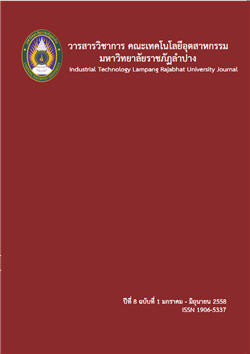การศึกษาผลของขนาดอนุภาคของทัลค์ต่อสมบัติเนื้อดินเอิร์ทเทนแวร์
DOI:
https://doi.org/10.14456/itjlp.2015.7Keywords:
ขนาดอนุภาค, ทัลค์, สมบัติเนื้อดิน, อุณหภูมิต่ำ, particles size, talc, body properties, earthenwareAbstract
การทดลองนี้ มีวัตถุประสงค์ เพื่อการศึกษาผลและเปรียบเทียบผลของขนาดอนุภาคทัลค์ที่มีต่อสมบัติทางกายภาพ และสมบัติ ทางกล ของเนื้อดินที่อุณหภูมิ 1150 องศาเซลเซียส โดยใช้วัตถุดิบ 5 ชนิด คือ โซดาเฟลด์สปาร์ ทัลค์ ดินขาว ดินดำ และซิลิกา รวม 8 อัตราส่วนผสม โดยทัลค์ที่ใช้แบ่งเป็นทัลค์ไม่บด และบดเพิ่มเวลา 3 ชั่วโมง ใช้อุณหภูมิสูงสุดในการเผา 1150 องศาเซลเซียส โดยเตาไฟฟ้า ขึ้นรูปแท่งทดสอบด้วยการหล่อ พบว่าการดูดซึมน้ำของเนื้อดินที่มีส่วนผสมทัลค์บด มีการดูดซึมน้ำ ร้อยละ 0.16 ส่วนเนื้อดินที่มีส่วนผสมทัลค์ไม่บด มีค่าการดูดซึมน้ำ ร้อยละ 0.21 ผลทดสอบการหดตัวของเนื้อดินที่มีส่วนผสมทัลค์บด มีค่าสูงสุด ร้อยละ 16.00 มากกว่าเนื้อดินที่มีส่วนผสมทัลค์ไม่บดที่มีค่า ร้อยละ 14.00 และมีความสัมพันธ์ที่เป็นไปในทิศทางเดียวกันกับผลการทดสอบ ความพรุนตัวของเนื้อดินที่มีส่วนผสมทัลค์บด มีค่า ร้อยละ 0.80 น้อยกว่าเนื้อดินที่มีส่วนผสมทัลค์ไม่บดมีค่า ร้อยละ 1.95 และถ่ายภาพจากกล้องจุลทรรศน์อิเล็กตรอน พบว่า เนื้อดินที่มีส่วนผสมทัลค์บด หลังเผาที่อุณหภูมิ 1150 องศาเซลเซียส มีขนาดรูพรุนที่เล็กกว่าเนื้อดินที่มีส่วนผสมทัลค์ไม่บด ผลการทดสอบความแข็งแรงของเนื้อดินที่มีส่วนผสมทัลค์บด มีค่าสูงสุด 192.63 MPaสูงกว่าเนื้อดินที่มีส่วนผสมทัลค์ไม่บด มีค่าสูงสุด191.60 MPa ในส่วนของปริมาณกากค้างตะแกรง ขนาด 100 140 200 และ 325 เมช พบว่า เนื้อดินที่มีส่วนผสมทัลค์บด มีปริมาณกากค้างตะแกรง สูงที่สุด ร้อยละ 0.68 0.19 0.32 และ 4.44 ตามลำดับ ซี่งต่ำกว่าเนื้อดินที่มีส่วนผสมทัลค์ไม่บด มีปริมาณกากค้างตะแกรง สูงที่สุด ร้อยละ 1.36 0.17 0.39 และ 6.00 ตามลำดับ จากผลการเปรียบเทียบสมบัติ การดูดซึมน้ำ การหดตัว ความพรุนตัว ความแข็งแรง และปริมาณกากค้างตะแกรงของเนื้อดินที่มีส่วนผสมของทัลค์บดเพิ่มเวลา 3 ชั่วโมง กับเนื้อดินที่มีส่วนผสมของทัลค์ไม่บดเพิ่มเวลา 3 ชั่วโมง พบว่าเนื้อดินที่มีส่วนผสมของทัลค์บดเพิ่มเวลา มีสมบัติที่ดีขึ้น และสมบัติที่พบใกล้เคียงกับสมบัติเนื้อดินสโตนแวร์ โดยเฉพาะมีการดูดซึมน้ำต่ำสุดที่ ร้อยละ 0.16 ซึ่งสูงกว่ามาตรฐานสโตนแวร์ ที่กำหนดไว้ตาม มอก.602-2546 ภาชนะเซรามิกที่ใช้กับอาหาร : สโตนแวร์ ไม่เกินร้อยละ 3 ดังนั้นเนื้อดินจากการทดลองนี้ มีแนวโน้มในการนำไปใช้ผลิตผลิตภัณฑ์ แทนเนื้อดินสโตนแวร์ได้
The Effect of Changes in Talc Size on the Properties of Earthenware.
The experiment studied the effects of changes in talc particle size on the physical and mechanical properties of soil heated to 1150° Celsius. The soil consisted of five ingredients: soda feldspar, talc, kaolin, black body, and silica. These were mixed in eight ratios, with the talc both un-ground and ground (for 3 hours). The mix was heated to a maximum temperature of 1150° Celsius in an electric oven, Examination of test bars showed that the water absorption of the material containing ground talc had a water absorption rate of 0.16%. The material containing un-ground talc had a water absorption rate of 0.21%. Material containing ground talc shrunk by 16%, compared to 14% for the un-ground talc. The porosity of the ground talc material was 0.80%; that of the un-ground talc was 1.95%. Electron microscopy showed that the mixture containing ground talc heated to 1150° Celsius had a smaller pore size than that containing un-ground talc. Strength tests of the former revealed a maximum strength of 192.63 MPa compared to the latter, which had a maximum strength of 191.60 MPa. Residue recovered from sieving through 100, 140, 200 and 325 mesh found that the ground talc compound left a residue containing the highest percentage at 0.68%, 0.19%, 0.32% and 4.44% respectively. The figures for the test material containing un-ground talc were 1.36%, 0.17%, 0.39% and 6.00%, respectively. These results show that the material containing ground talc (which had been ground for longer) had properties which were preferable and which were closer to those of stoneware clay. In particular, it had a low water absorption rate (0.16%) and this exceeds the stoneware standards as defined by TIS. 602-2546 for ceramic containers used for food, which should be no more than 3%. The material tested in this trial could therefore be used instead of stoneware for producing ceramic containers.






